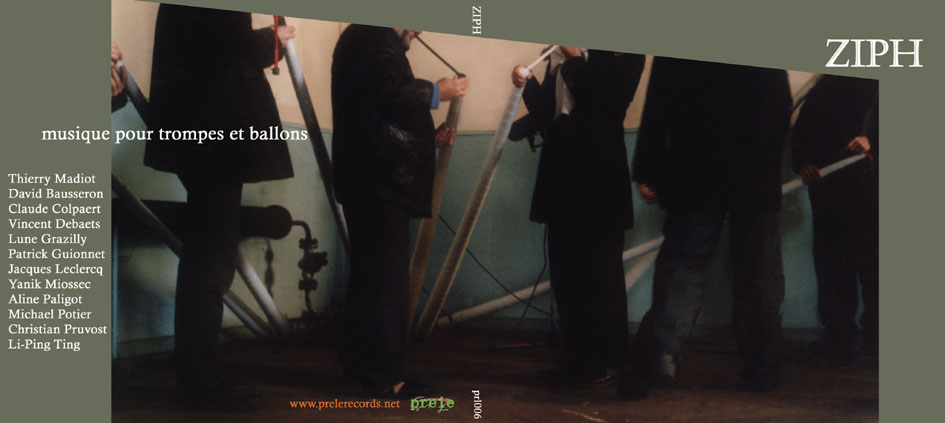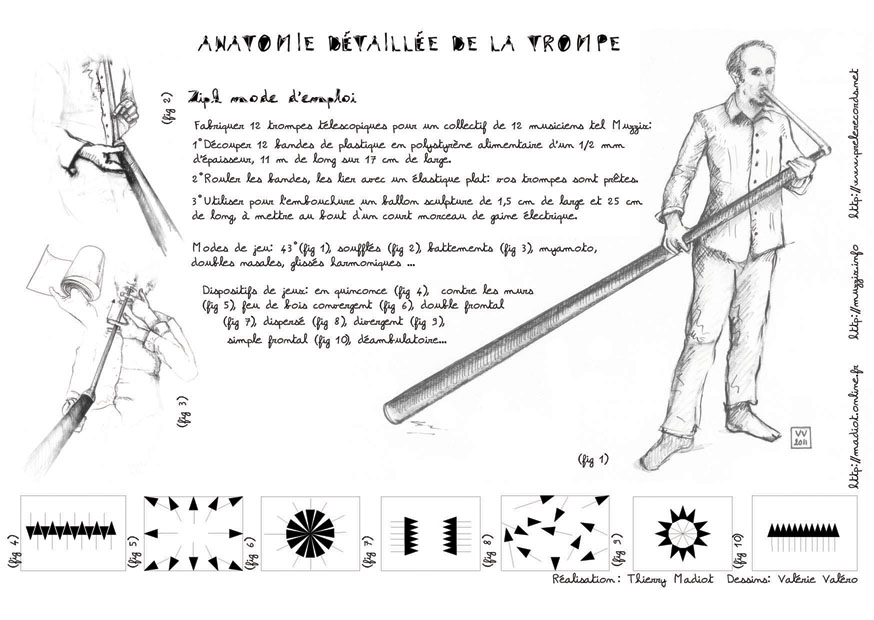prl006
Ziph / dirigé par Thierry Madiot

David Bausseron, Claude Colpaert, Vincent Debaets, Lune Grazilly, Patrick Guionnet, Jacques Leclercq, Thierry Madiot, Yanik Miossec, Aline Paligot, Michael Potier, Christian Pruvost et Li-Ping Ting
Compositions: Thierry Madiot
A force de démonter son trombone, d’y souffler à l’envers d’y brancher des tuyaux en caoutchouc ou des ballons de baudruche, Thierry Madiot a fini par inventer un nouvel instrument : Ziph.
En apparence fort simple, le Ziph n’est constitué que de 3 éléments, un ballon de baudruche reliant un rouleau de revêtement de sol à un anneau. Le rouleau de matière plastique, vrillé forme une trompe qui assure l’amplification et la multiplication des harmoniques. L’anneau maintient ouvert le ballon de façon à offrir à l’instrument un orifice de type embouchure de cuivre. Mais le plus étonnant est le ballon dont le fonctionnement de base, par ses 2 parois en vibration, est analogue à une double anche (famille des hautbois). À partir de là, tout se complique du fait que le ballon soit long et élastique. Ainsi cette double anche molle peut être étirée, malaxée, triturée, démultipliant les modes de jeu. On l’aura compris, cet instrument est un hybride inclassable qui a à voir avec les trompes, les cuivres, les hautbois et pas seulement. Instrument contemporain, il n’est pas focalisé sur la hauteur du son et de ce fait il fait parfois penser plus à un instrument électronique qu’a un rejeton de la famille des vents. Ensuite le son étant généré par un genre d’anche, l’instrument génère des harmoniques qui sont à leurs tours favorisés par la trompe, il en résulte un signal granulaire pour ne pas dire parfois distordu. Ziph est donc un instrument acoustique qui se fait parfois passer pour un instrument électronique. Les instruments varient en taille allant de 2 à 20 m et pour cet enregistrement, il est joué en orchestre de 2 à 13 personnes.
By dint of dismantling his trombone, to blow in it in a reverse way, to plug pipes and rubber balloons on it, Thierry Madiot ended up inventing a new
instrument: Ziph. Seemingly simple, the Ziph only consists of 3 elements, a balloon between a roll of floor covering and a ring. The roll of plastic, twisted form a horn that provides amplification and harmonic multiplication.
The ring keeps the balloon open in the way it gives the instrument a mouthpiece of brass instrument style. But most astonishing is the balloon that operate between its two parts of the membrane some vibrating, is analogous way as double reed (oboe family). From there, everything is complicated by the fact that the balloon is long and elastic. Thus this double reed soft can be stretched, kneaded, triturated, multiplying the ways of playing. Consequently that instrument is an unclassifiable hybrid that has something to see with the trombones, brass, oboe and not only. As a contemporary instrument, it is not focused on the pitch and thus it is sometimes close to electronic instruments more than a son of the family of wind instruments. Then as the sound is generated by a kind of reed, the instrument generates harmonics which are in return encouraged by the horn, and it result a granular signal not to say sometimes distorted. Ziph is an acoustic instrument that sometimes pass for an electronic instrument. The instruments vary in size from 2 to 20 m and for this record, it is played in by a band of 2 to 13 musicians.

Capté en direct deux pistes et masterisé par Éric Cordier
Production artistique et coproduction discographique : Muzzix-Le Crime